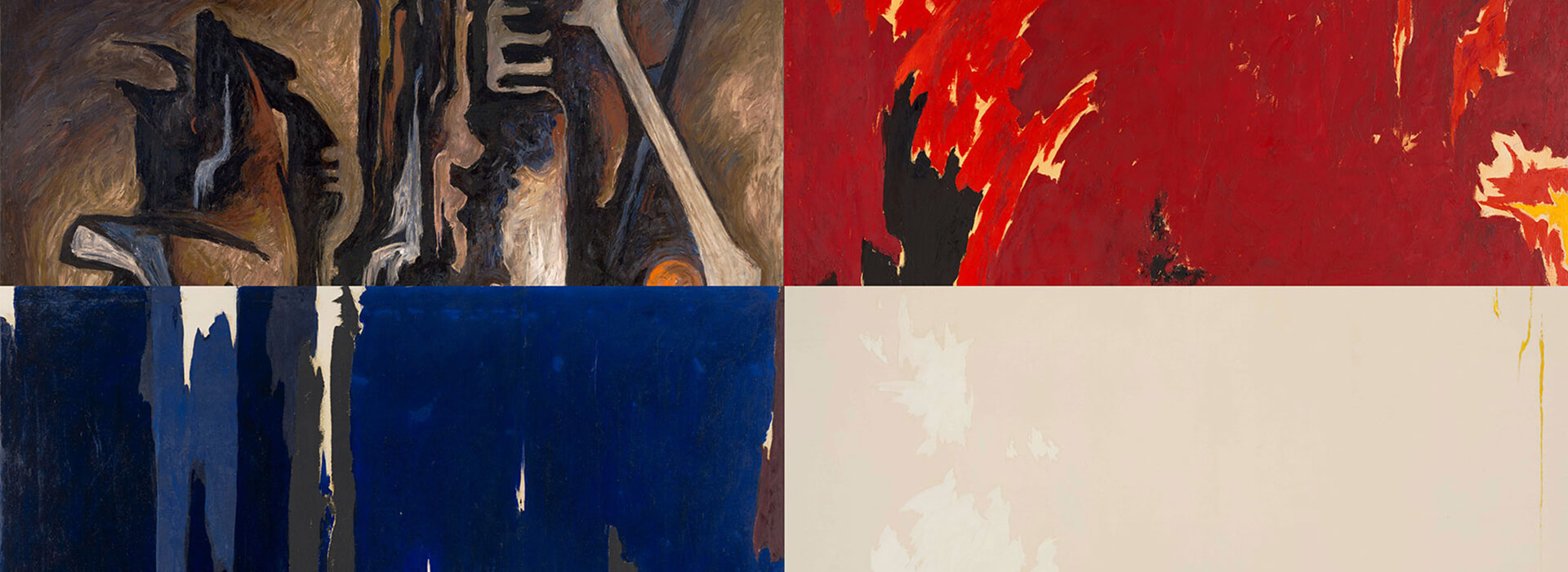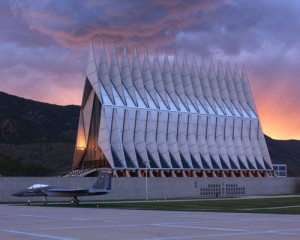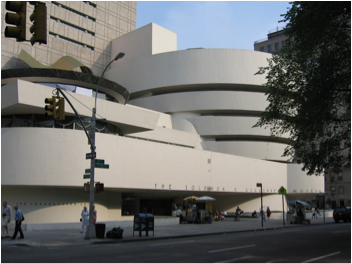Robert Venturi published Complexity and Contradiction in Architecture in 1966 as a critique of modernist architecture, primarily as it had developed since World War II, and particularly during the 1950s. His manifesto called for an architecture that would be richer in its forms and meaning than modernism, stating of the modernist approach “less is a bore” (his critique of Mies van der Rohe’s famous aphorism “less is more”).
Left: Air Force Academy Chapel, Walter Netsch architect (1955-63) (Skidmore, Owings and Merrill) Right: Guggenheim Museum, Frank Lloyd Write, architect (1943-59)
As an architectural historian today, I look at the decade of the 1950s with fascination. In the United States in particular, it was a decade that was balanced between the transcendent aspirations of artists and architects who are often defined as Modernists, and the counter-response from a younger generation of artists and architects who would become defined as Postmodernists. I began researching and writing on that period while a graduate student, in part because I was concerned by the lack of attention the decade had received in terms of architectural history. That was due in large part to the critiques of many prominent architectural historians, who associated the International Style with this country’s consumerist and corporate structure, and stated that the architecture had lost any social (or socialist) connection that the Modern Movement might have originally had. Summarily dismissed, the decade seemed lost to critical evaluation by historians, and in the aftermath of Postmodernist responses to architectural Modernism, was neglected to an even greater extent. Only in recent years have some of the prominent architects associated with that period been discussed. Work by early leaders of modernism, such as Gropius, Mies van der Rohe, or Le Corbusier, was often defined by the work they did prior to the 1940s, and even Wright, an American architect whose work was well-known and championed in the United States, was discussed primarily within the context of his work up until World War II. The work during the last decade of his life, the 1950s, was viewed as idiosyncratic.
My own research has focused on this “lost decade.” I was initially drawn to research one of the largest single educational projects in the country’s history, and one of the largest government-funded projects of the decade, the United States Air Force Academy – a project that had been virtually ignored by architectural historians. The project was overseen by Skidmore, Owings and Merrill, a firm was one prominent architectural historian characterized by stating that they created an “architecture of bureaucracy . . .from which all personal expression is absent.” Thus dismissed, the richness of the dialogue and debate that centered on the Academy’s construction in both the public sector and in Congress was ignored. In fact, concerns that centered on issues of architectural meaning in the Cold War era crystallized with those discussions and would provide a foundation for further dialogue and debate in the next decade.
The decade of the 1950s, of course, was not simply defined architecturally by a singular approach, but was complicated in the concerns it addressed, as was the rest of the art world. The background to those concerns was the social and political context of the aftermath of World War II and the subsequent Cold War. Although Stalin died in March 1953 and the Korean War ground to a close later that year, within a few years Sputnik would be launched into space and the Cold War would intensify. Within a decade, Kennedy’s assassination and the social upheaval of the late 1960s would create a very different artistic climate in this country. The continual specter of nuclear warfare after the inconclusive settlement of the Korean War, and the public’s eroding faith in simplistic technological and political solutions in the wake Hiroshima and the Holocaust created, for many in the art world, the need for a new search and reevaluation of meaning at both the personal and societal levels.
Architecturally, Le Corbusier was searching for a new language of primal power with his work in France during the 1950s, and found it in several religious projects that he completed. Wright’s work during that decade culminated in the Guggenheim Museum, a structure that embodied his search for an organic expression of the mythic in architectural form. Even Mies van Rohe, with an International Style modernist vocabulary, was inspired by the writings of St. Thomas Aquinas and the search for a transcendent and spiritual form while working on projects such as the Seagram Building. At the Air Force Academy, the Cadet Chapel became the focal point of the Cadet Area ensemble, reflecting the values of a decade when “In God We Trust” officially became our national motto, and “under God” was added to our pledge of allegiance.
These overlapping concerns, of course, parallel those of the Abstract Expressionists and Clyfford Still, so a discussion of the architectural climate of the 1950s is relevant within the context of Still’s November 1959 exhibition at the Albright-Knox Museum. In fact, his exhibition opened several weeks after the Guggenheim Museum officially opened, signaling an end to a decade that ultimately defined itself in terms of its complexities and contradictions. Needless to say, I’m excited to discuss some of the architectural concerns of the 1950s in my talk on March 6, and hope for a lively discussion following the talk.


